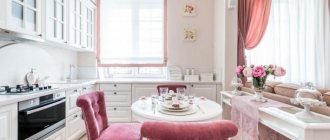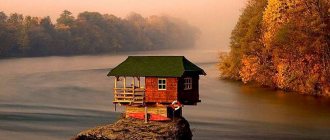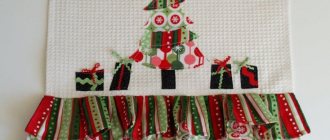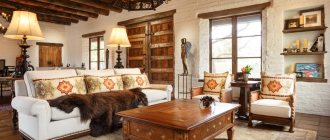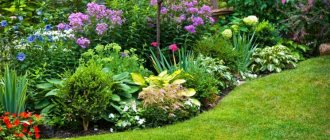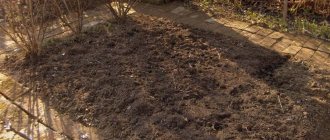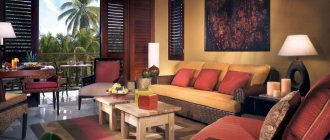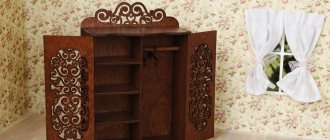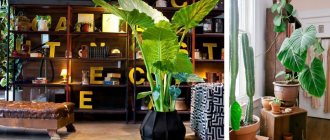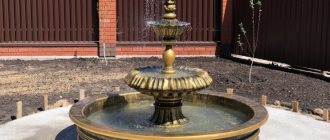Design of a small area and design rules
Focusing on modern trends in landscape design, you can use a few simple, basic rules for carrying out such procedures.
Preliminary design and zoning of the territory will help to implement any solution with the right choice of design style for the area in front of the house or surrounding the building:
Refusal to erect massive structures; during the construction process, it is recommended to choose projects that look light and elegant and do not overload the free area of the site.
All permanent and mobile buildings must be positioned correctly, choosing the right space zoning techniques, alternating structures and recreation areas, flower beds and front gardens.
It is recommended not to use blind and high fences on your site, which limit the space and visually narrow it; it is better to choose structures that can be viewed.
The correct choice of plants for landscaping will provide a visual expansion of the space and will help to avoid placing overgrown shrubs and trees with a lush crown on the site.
In a small area in front of the house, the general concept of the design of the site should be clearly visible, which is achieved by observing these rules.
Harmonious landscape design helps to decorate and transform the space, and individual elements of the arrangement will attract the attention of passers-by and invited guests, pleasing the eyes of the home owners.
No. 9. Relaxation area and gazebo on a small area
A suburban area not only offers relaxation - it was created for it, and nature creates a considerable appetite, so it’s worth thinking about organizing a recreation area and/or barbecue area:
- even in the smallest area one can distinguish space for a bench or a small dining table with 4-6 chairs. If we take into account that most garden furniture is compact, light and mobile, then such a dining area can be removed from the site if necessary;
- a massive gazebo is the prerogative of spacious areas, but on 5-6 m2 of territory you can place a completely comfortable recreation area. Of course, it is better to abandon blank walls, giving preference to light openwork structures that let in light and allow you to see what is behind the gazebo. In fact, the design comes down to a canopy and not very bulky supports and low fences. Fabric awnings and tents are perfect;
- barbecue area can also be located in a small area. If you are a fan of picnics, but do not particularly like to take care of your vegetable garden, garden and flower garden, then the barbecue area can become the center of the site, occupying a significant area. In this case, it is equipped with a massive stove, and landscaping is done with the help of a lawn, unpretentious flowers, shrubs and trees. If the area is small and you need to fit a lot of zones on it, then it is better to organize a place for a picnic using a portable grill or barbecue, light garden furniture and a canopy;
- You can create a cozy relaxation area by installing two pergolas, connecting them with slats and planting climbing plants.
Regular style
This style is characterized by an axial division of the existing territory and a symmetrical arrangement of all design elements.
This style is characterized by the use of certain geometric shapes, which are visible in any design, flower beds and garden plantings, outbuildings and decorative elements.
Choosing a style
To prevent a small garden from appearing even smaller, it is important to know a sense of proportion regarding decorative elements. Also, even at the project stage, decide on the height of objects and plants. Objects that are too voluminous will “draw” attention to themselves, and the impression of the landscape as a whole will be hopelessly spoiled.
To prevent a small area from appearing even smaller, when working with its design it is important not to oversaturate it with decorative elements.
The ideal style for a small garden is Japanese. Mandatory “residents” of such a site: dwarf trees, mini-waterfalls, compositions of stones. Traditional hedges serve as decoration. And when choosing plants for an oriental-style garden, preference is given to evergreen shrubs, various types of moss and creeping grass.
Ideas for landscaping a small area
Interesting and bright ideas, distinguished by their originality and freshness, will help transform the site without significant investment.
For a practical and stylish design of the area in front of the house, you can use certain ideas that help landscaping the area without overloading it and visually expanding the entire space.
Horizontal flower beds
Narrow or raised flower beds will help preserve free space and are used for visual zoning of the territory with its full decoration.
For such flower beds, it is recommended to select plants and flowers that will delight with bright colors throughout the spring, summer and autumn, right up to early winter.
Vertical flower beds
Unique vertical gardening solutions are used for small areas in front of the house, as the best way to save free space.
Pergolas covered with greenery and multi-level flower beds made from scrap materials, flower pillars and towers act as vertical flower beds.
Organization of landscaping
Too tall trees will make a small area optically even smaller. It is better to give preference to low or dwarf varieties. Otherwise, it will be necessary to constantly trim the branches, creating a small crown. This will also help in growing other plants that would otherwise not get sunlight.
The southern side is usually given over to low-growing plants (vegetables, berries, flowers), and fruit trees are moved closer to the northern border of the garden.
An excellent solution would be vertical gardening, which will perfectly help reduce space consumption. Most often, hanging flower beds are used in this way, but this option is also perfect for growing strawberries, herbs or cucumbers.
Container plantings
In specialized flower shops and construction supermarkets you can purchase spacious and aesthetically designed containers for flowers.
It is easy to build flowering slides from them, or using such decorative elements it is practical to decorate fencing structures and fences, verandas and recreation areas delimiting the area of the site.
Landscape design and decoration of the site
Independent choice of design composition involves use on a site with a limited area and involves the selection of functional and decorative elements.
The owners of the site may not give up interesting ideas in favor of preserving free space, but it is important to focus on a balanced approach in drawing up a landscape composition.
Big ideas for a small garden
Regular style in a small landscape
Do not think that the regular palace style is only suitable for large areas.
Neatly trimmed shrubs, lawns and geometric flower beds, slender trees in tubs, and narrow garden paths are also suitable for a small garden. Arches entwined with climbing plants, such as roses, look very appropriate. You can make a small garden more cozy with a sophisticated bench or a pair of garden chairs. You shouldn’t give up on a small pond with a stone frame – this element of landscape design will decorate a site of any size.
The basic rule for designing a miniature garden is laconicism, so it is better to avoid:
- a large number of decorative elements (fountains, sculptures);
- excessive riot of colors - one or two bright colors are more than enough;
- voluminous shrubs; plants with large flowers.
Small garden pond
Small landscape garden
You can feel yourself in the lap of nature even if you are in a tiny garden. A small pond in the center of the composition - a pond made of a plastic mold or film waterproofing - will help create the atmosphere of a wild landscape. A small stepped waterfall will visually increase the area of the water space.
To design a near-water area, it is better not to use large stones - they will make the pond seem even smaller than it actually is. The “carpet” of various ground cover and flowering moisture-loving plants, placed immediately behind the rocky edge of the reservoir, looks very impressive.
In search of compact solutions for garden design, useful ideas for a small garden, design techniques and devices will help you increase space, and, what’s especially nice, old and unnecessary things will come in handy for many of them.
Vertical rockery
Vertical and multi-tiered compositions
Climbing plants and vertical compositions made of stone - rock gardens, rock gardens in the form of a steep hill or towering terraces - look very beneficial in a small garden. In a small area, it is better to place them in the farthest corner so that you can appreciate the overall picture of the view from afar.
Garden mounted on the wall
Before creating a landscape design for a small garden with your own hands, you need to think about how to obtain additional area for landscaping in the conditions of a particular site. This can be done using multi-tiered or wall-mounted structures.
These are:
- flower beds made from car tires;
- raised snail beds;
- multi-story or stepped flower beds;
- flower beds made from old furniture with drawers;
- shelves with shelves for beds; wall containers with plants;
- textile or plastic “pockets” for growing.
Tires for growing flowers
Thickets under the ceiling
You can increase the space of a miniature garden using hanging structures. These can be either pots or metal “baskets” in the form of a sphere or hemisphere with holes, which are covered from the inside with a special coating. Such a garden is often located under the ceiling of the veranda or on specially made posts with curls. Begonia, fuchsia, petunia, purslane, allisum, and pansies look very attractive in hanging flower beds.
Hanging baskets for a portable vegetable garden
Hanging containers are suitable not only for flowering plants - they can also be used to play up the design of a small vegetable garden. Arugula, various varieties of lettuce, spinach, sorrel, parsley and even strawberries can be safely grown in hanging beds, arranging them in several floors to save space.
Hanging flower beds
Convenient mobile garden
The term “mobile garden” often refers to vegetation planted in pots. This is an excellent solution for a small area - the plants can be moved or removed indoors at any time. This garden looks good on multi-story structures, stairs, verandas, near paths, gazebos or the entrance to the house.
When choosing containers for the inhabitants of a mobile garden, it is necessary to take into account the size of the adult plant and its root system. The range of plants for such cultivation is quite large - from popular patio roses to low-growing coniferous shrubs and even vegetables: tomatoes, peppers and others.
Mobile garden in pots
Arranging a landscape with a small area sometimes requires a more serious approach than working with a vast territory. Not all of your preferences may be compatible with limited space. Therefore, to design a small garden, it is worth using the help of a professional landscape designer - this way you can use the territory of the site with maximum benefit, and your wishes will be skillfully adapted to its small size.
Viewable fence
Owners of small areas in front of the house should abandon massive and capital fences using visible fences.
To increase security and hide the area from prying eyes, a picket fence or chain-link fence is planted with climbing plants, which will help to provide additional landscaping to the area.
Effective use of a small area
If they tell you that it is impossible to grow anything and relax on a dacha plot of 3.5 acres, do not believe it! If desired, your acres can be a beautiful and cozy piece of paradise, also with berries and vegetables! Here are a few tricks to use. Maximum use of land area
There should be no unused areas on the site; every square centimeter of land must be used, freed from weeds and household rubbish.
Land along fences, etc. should also be occupied with plantings. Effective planning of the site and crops
To effectively use land in small areas, it is necessary to carefully approach their planning.
Firstly, a minimum area must be allocated for domestic and commercial buildings (greenhouses do not belong to them, since they are used for planting). Secondly, you need to abandon the beds of the correct geometric shape and the countless paths between them. On the site, you should allocate a place for a recreation area, which can be small, closer to the house, or it can be a lawn (or lawn) from 3 to 30 m². It is better to arrange a pond (or pond) with a volume of 20 liters to 200 liters nearby. Of the paths, you need to leave one central, straight one, it will visually lengthen the area. An arch should be made in the middle or at the end of the path (this element will visually create the effect of continuing the section). In the foreground, next to the house, it is worth placing plantings that are “pleasant to the eye and soul,” most often these are flower beds, rose gardens, but, of course, small in size and simple in shape. The vegetable garden must be located away from the recreation area, out of sight, and not clearly marked out, then it will create the impression that the area is used mainly for beauty and relaxation. It is very successful in planning a small plot to use any elements of vertical gardening (posts, pergolas, arches) that will separate zones of certain plantings. Agrotechnical practices play an important and significant role in crop planning. Using the technique of compacted crops and mixed beds
It is more difficult to change crop rotation on a small plot than on a large plot, so it is necessary to use the technique of compacted crops and mixed beds. For example, sow carrots with onions, “beat” with radishes, lettuce, or cucumbers with radishes and dill, beets with cabbage. It is convenient to plant cucumbers next to corn, which will serve as a support for the cucumbers. You can “knock out” the gladioli with salads, then the soil will dry out less, and the green and burgundy (Lolla Rossa) carpet, above which beautiful gladioli flowers rise, will look very beautiful.
Using different periods of sowing and ripening of plants
It is better to make a border from a mixture of seeds of curly parsley and lettuce: parsley takes a long time to sprout, lettuce will quickly mark the border, and lettuce leaves can be added to food.
During this time, the parsley will grow - and there will be a lush green border until autumn. It is very convenient to place early vegetables (salads) and flowers (tulips, daffodils, muscari) under bushes. While the bushes have not grown, flowers and early greenery will have time to produce a harvest. Some summer residents use the “one-to-one” method of sowing radishes, that is, they sow several times in the same area: they pull out the grown radishes and put a new radish seed in the same place - they get a “long-lasting” bed. You can get two potato crops on one area - this is from my experience. The appointment requires additional preparation. It is based on the use of different sowing dates. The same technique is used when sowing onions and carrots together: the onions are harvested first, and the carrots grow further. Selecting plants using their characteristics
As a rule, large, spreading plants are not used in plantings in small areas.
It is unlikely that it is effective to plant crops in the stale form in such areas. There are varieties of shrubs, for example, currants, in which the bush is compact. It is also not effective to plant plum trees in small areas (from my experience), since the plum tree is a fairly spreading shrub and does not like to be watered often, or dug under it, that is, the area under the plum tree cannot be used for other plantings. Among vegetables, it is useful to plant standard varieties of tomatoes, bush zucchini, etc. You can plant dwarf plants (roses, spirea, etc.), as well as climbing plants (roses, honeysuckle, beans, etc.), the latter of which can be directed up. Vertical shaping of plants
This technique can be used when planting ordinary plants, for example, forming apple trees in a pyramidal shape, trimming ornamental shrubs and shaping them into various shapes, monitoring the plants and preventing them from growing too much.
It is necessary to carry out preventive pruning more often. Cucumbers can be grown not on standard, long beds that take up a lot of space, but on compact, round beds with a diameter of about 1 m. Cucumber seeds (about 10 pieces) are sown in a circle. Near each seed, a metal hook is buried in the soil, and a high (3 m long) pole is installed in the center of the bed. A rope is pulled from its top to each hook and a film or non-woven covering material is thrown over the resulting rope frame-tent, while one edge of the film is collected and secured to the top of the pole. As the plants grow, the cucumber vines rise up the ropes. Thanks to this, the sun's rays reach the shoots, good ventilation is ensured, and pollinating insects actively visit the flowers - and in July the plants produce a good harvest. By the way, recently experts often say that, due to the above reasons, it is better to grow cucumbers on a trellis. The tent bed itself is a good decoration for the garden. For crops such as melons and pumpkins, it is perhaps difficult to build such a bed: the vines of these plants are very massive and long, and their fruits are heavy. However, these plants will feel better, and space on the ground will be freed up if their runs are wrapped around some reliable support (tree, fence). Some send pumpkin or melon vines further away - closer to the sun - on the roofs of outbuildings. Firstly, shoots and fruits feel good there: warm, dry. Of course, the seeds of these crops must be planted in close proximity to the wall of the utility block. Secondly, plants need a “ladder” support in order to climb onto the roof. And, of course, this technique is only suitable for long-climbing varieties. Some gardeners allow pumpkins, watermelons, and melons to “settle” on the walls of a residential building. The fact is that the walls of the building, which heat up during the day, then give off heat to the plants. In this case, garden crops, as a rule, are planted in fairly large containers with a nutrient mixture placed near the house, and a system of “checks and balances”, that is, supports and supports, is required. Reducing the number of plants through grafting
Using this technique, you can have several varieties of fruit trees on your site, while the occupied areas will be reduced many times if you grow a “garden tree”.
When there are two or three apple or pear trees on the plot, you can harvest ten to twenty varieties of apples and pears. The same applies to grapes. Using Multifunctional Plants
What is it?
Plant plants that perform two or more functions. For example: - a rosehip hedge is a hedge, an ornamental plant (flowers and aroma) and useful fruits; — climbing beans are decorative decorations and fruits; or radishes and mustard - sow in a “tomato” place in early spring on greens, then dig them up before planting tomatoes (green manure function); — corn can be planted both to produce cobs and as a support for cucumbers; - cyclantera has excellent decorative properties, and also has wonderful healthy fruits; — we must not forget about onions, which are used both as an ornamental and as a useful plant. My personal experience
On my site, I use all the techniques for effectively using a summer cottage with the exception of hanging beds. As a result, on a plot of 3.2 acres I plant almost the entire range of common (and not so common) plants. Three apple trees were planted on the plot, on which four other varieties were grafted, three cherry bushes (it so happened that one bush grows directly from a chokeberry bush, with chokeberry on the bottom and cherry on top), four black currant bushes, a gooseberry bush, raspberries (three varieties), both actinidia and grapes grow. I even plant potatoes along one side of the fence in one row, I place corn between the potato holes, they don’t interfere with each other. Garlic grows in strawberries, I plant carrots in three rows along one greenhouse, I plant celery in two rows along another greenhouse, alternating with kohlrabi cabbage, I plant onions under apple trees.
In greenhouses (tomato and cucumber), I form plants on trellises, tying them up. In the tomato greenhouse I get a harvest of mustard greens and radishes before I plant tomato seedlings there, and there is also a designated place for cutting plants.
In the cucumber greenhouse, before cucumbers, I grow dill, early lettuce, flower and cabbage seedlings. In May, I plant cucumber seedlings there, when these seedlings grow up, we already eat the salad greens, and I plant seedlings of flowers and cabbage in open ground. There is room there for some varieties of peppers and green beans - cowpeas. I only grow beans as climbing beans, along windows and along the other side of the fence. There are zucchini, eggplant, three types of cabbage, and much more! But the most important thing is that there are flowers all around!!! The harvest is enough for three families in the summer-autumn period; from the harvest we only make what is stored in the apartment (since there is no cellar).
On the site there is a house (4*6 m), two greenhouses (3*6 m), a bathhouse, a lawn (about 20 m²) with a horizontal bar, a 250 liter pond with a fountain, a concrete area for a car and all the plantings.
That's how wonderful our 3.2 acres are!!!
Garden paths
In order for the design of a small garden to meet modern ergonomic and aesthetic requirements, it is important to design garden paths correctly and in an original way.
Smooth curves and loops, the absence of straight geometric shapes will help visually expand the territory, and to limit the paths it is better to use small decorative elements and lighting.
Small plot design styles
Landscaping of a small area is usually done in natural styles. Geometric designs will require significantly more space.
Most often they use the English layout, characterized by smooth lines and a little natural negligence, the forest style, characterized by simplicity and minimal maintenance, and country styles, which make the site a bright and memorable place.
Ornamental grass: review of the best decor options and instructions for using ornamental grass (170 photos)How to design a flowerbed - instructions, diagrams, types and options for proper placement of a flowerbed (140 photos)
- DIY flower beds - 180 photos of unusual ideas for beginners and features of their application
For lovers of the exotic, the easy-to-understand Japanese style, alpine design with the absence of fences, minimalist design with straight paths and laconic design elements are perfect.
Garden arrangement
Gardening enthusiasts can create a beautiful garden, even in a small area, using the principles of grouping fruit trees and shrubs.
A multi-level garden, in which trees and bushes are located on terraces, will decorate the area and ensure harvesting while maximizing savings of free space and usable area.
No. 8. Small plot and big trees
Many tall trees in a tiny area will not look entirely appropriate, but several large trees can be planted. Even on 1 hectare there is room for one large size, which will provide noticeable coolness in the summer. Moreover, you can plan a recreation area around a large tree . On a plot of 6 acres you can place a small planting of fruit trees. You can also use low-growing varieties of fruit trees, evergreen conifers and tall shrubs.
Additional decor
It is not always possible to decorate a small and narrow area using flower beds and arrange a recreation area on it, and decor will help solve the design problem.
Crafts made from scrap materials and beautiful flower pots suspended on vertical structures will add bright accents to the landscape and help transform it.
In a cup
If you don’t have a suitable container for a mini-garden, you can even arrange it in a cup. It looks very original. Moreover, such a garden takes up very little space.
A picturesque miniature landscape or garden in a pot is an original design element that can decorate any corner of your site, as well as a balcony or terrace. The choice of plants for the composition depends on the theme of the mini-garden. Don't be afraid to fantasize and bring even the most incredible ideas to life.
